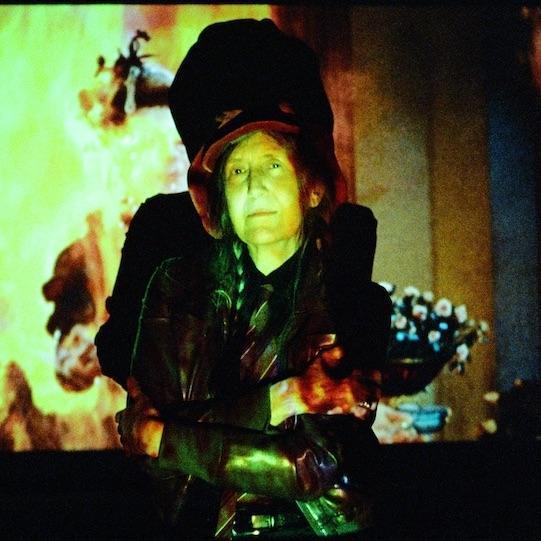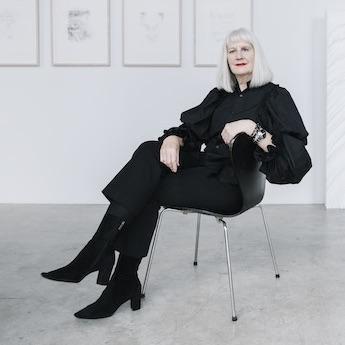Siding With The Monster
With works gentle and violent, sexy and intelligent, Maria Kozic has spent the last four decades bringing her audience into a new world.
Words: Ingrid Periz
Photography: Nico Marquez
Maria Kozic is suffering from some Covid- induced fogginess when we talk about Wonderland, her forthcoming show at Melbourne’s Neon Parc gallery. “I feel like I’ve run marathons,” she says after her second bout with the virus. Covid seems to lurk in different forms in her recent work as well even though it was made just before the pandemic broke. Kozic adds, “You don’t need Covid to see how sick the world is.”
The Melbourne-born artist lives in Brooklyn New York, near the East River where she can watch the lights of the city with barges and ferries passing by. She makes daily visits to a little urban beach – more shingle than sand – to find treasures among the wave-borne rubbish. Her part of Brooklyn is in an old Italian area where she says, “I’m one of the last remaining artist people here.”
Since the late 70s Kozic has made a great range of work – installations, sound record- ings, prints, sculptures, paintings, films and videos – indebted to pop culture. The Birds, 1981, Kozic’s installation of almost 100 black birds inspired by the Hitchcock film, now in the National Gallery of Victoria’s collection; her Maria Kozic is BITCH, 1990 poster campaign; and her glowing, inflatable Blue Boy sculpture, 1992 atop Sydney’s Museum of Contemporary Art, are iconic examples of her play with what used to be called high and low cultural forms.
Several decades later she feels some distance. “The whole thing of pop culture, I don’t even see it. It’s just…culture. It’s just real life.” Along with the TV shows from her childhood she gets inspiration from salvaged bits of wood – fashioned into figures, these became the beginning of Blue Boy – and she remembers her Serbian-born father “telling me stories about being chased in the woods by a ghost force,” which calls to mind the recent Australian/Macedonian film You Won’t Be Alone, and seems to haunt some of the work in Wonderland. Her enthusiasm for science fiction’s “messing with other worlds” and horror film’s capacity to “soothe” anxiety is that of a connoisseur. She tells me, “Since I was a kid I always sided with the monster.” She can be an absolute fan as well. At a film screening at New York’s Museum of Modern Art, Kozic gave two of her monster paintings to Nightmare Alley director Guillermo del Toro. She laughs, “I turned into a ten year old girl. My lisp came back. I said ‘I love monthterth’ and he kissed me on the cheek.”
It’s not just mass mediated imagery that draws her. “I find everything interesting,” she says. “I don’t have to do research. Everything seems to be of importance. I was in a bathroom with an automatic soap dispenser and it made such a wonderful sound I recorded it. There’s a joy in things. But then there’s the state of the world that’s distressing.” Responding to this world, often through concurrent series featuring little beings that sometimes look like cartoon figures, is solace. She adds, “When I’m working, everything else goes away.” Wonderland comprises a dozen or so small, domestically-scaled paintings of entities she calls “creatures” inhabiting or passing through a variety of landscapes. “My idea is that the creatures are a stand-in for humans.” These fully formed if undefinable little entities have an uneasy relationship with their surroundings, those varied backgrounds Kozic works up from photographs of local sites and generic landscape paintings from her childhood home. Everything is marked with a kind of post-Covid melancholy; there’s nothing heroic about the creatures. They don’t struggle so much as lurk. All are in a state of anxiety where, as Kozic puts it, “bad stuff is about to happen.”
Little figures fall from orange skies, a pink genderless Ophelia with a scarred tummy floats by – “it hasn’t had a good day.” Apricot sunsets mix “horror and hell”, ectoplasm billows like a viral load over a nocturnal cityscape, and a wee blue munchkin wanders at the end of the earth. Kozic’s creatures are funny and there’s a warmth in her approach that suggests she can feel their pain. At the same time their worlds – generic or malign – are as much in need of repair as this one. She says, “I find everything so ridiculously fucked up, I don’t know why it hasn’t been fixed.”
More than 20 years ago critic Adrian Martin ended his appreciation of Kozic’s work this way: “The art of Maria Kozic…perennially leads its viewers into a new world by way of shocks gentle and violent, provocations exact and disarming, revelations sweet and profound.”
GEOFF NEWTON
Director, Neon Parc, Melbourne
Neon Parc’s director Geoff Newton explains the continuing interest in Kozic’s work: “Maria’s work hasn’t been as visible as it should be within Australia, yet her work has consistently been featured as part of thematic institutional exhibits.” (Maria Kozic is BITCH was included in Unfinished Business: Perspecitves on Art and Feminism at Melbourne’s Australian Centre for Contemporary Art in 2017-18.) He continues, “The appeal is her approach. Using part trash culture, part Pop catharsis as her subject, Maria has produced a body of work which is punchy, sexy, intelligent and raw. For me it’s the take-it-or-leave-it attitude which I admire greatly.”
Newton thinks Kozic’s work will fit with that of other members of Neon Parc’s gallery stable such as Janet Burchill and Jennifer McCamley, Elizabeth Newman, and Dale Frank because all “have a similar reputation in terms of their singular influences and contribution to contemporary art in Australia.” He says, “Many young artists under 40 are now making work which represents a similar spirit to Kozic, a kind of punk ethos…the desire to express ideas is key. I know for a fact the Bitch billboard from 1990 is still referred to at art schools in Melbourne and whenever a work by Maria from a museum collection is on public display, word gets around. Prospective collectors should look at the new exhibition as an extension of her seminal earlier works.”
HELEN HUGHES
Senior Lecturer in Art History, Theory, and Curatorial Practice, Monash University, Melbourne
Maria Kozic’s work is treated as canonical in most Australian art history courses across the country – particularly in the sections of the syllabus that deal with postmodern- ism, gender, and feminist art. Indeed, I was first introduced to Kozic in undergrad – and specifically to her iconic billboard Maria Kozic is Bitch, 1990. I now live with a mounted poster of one of Kozic’s pinups holding what looks like a semi-automatic rifle in her left hand (Bitch (Jackhammer), 1989, which was a gift from the film critic Adrian Martin). The visions of self-possessed women that Kozic constructs in many of her works are indisputably powerful and arresting. The strong sense of humour, which is often very dark, is also a factor in Kozic’s large and abiding fan base. But what is ultimately most compelling about her practice is her command of imagery – her work always shines brightly at a formalist level, even before it opens onto its complex array of social and political issues. This is especially impressive when you consider the wide range of media across which she works.
One of the most critically important aspects of Kozic’s work is the way it examines how identity – how people themselves – are constructed from and shaped by the things they culturally consume. Kozic’s fleshy, Cronenberg-style, weapon-like objects (a gun, bottle, a severed hand, and hammer) gestating in hospital incubators for newborn infants held in the collection of the Art Gallery of New South Wales (Pulse, Mk2, 1994) speak to the way institutionalised violence (whether sexist, classist, racist, transphobic, etc.) is enculturated from birth. They continue to be of interest, especially against the backdrop of the current news cycle replete with American schoolyard killings.
Now more than ever, the post #metoo moment demands a widespread critical awareness of how female subjectivity is constructed through media, law and language, as well as the tools for deconstructing damaging gender-based stereotypes. Kozic’s work has addressed these issues for decades with rigour, poise, and, most disarmingly, a slightly warped sense of humour. She is well overdue for a major museum retrospective.
This article was originally published in Art Collector issue 101, July to September 2022.







